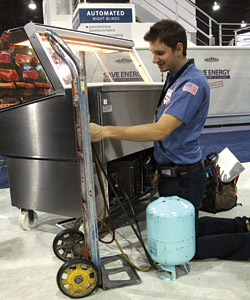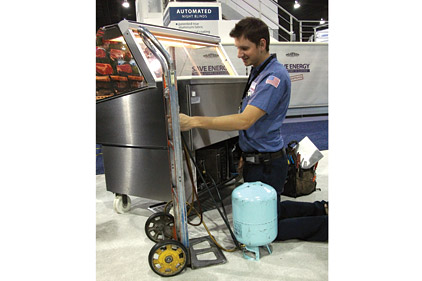
|
| A service technician works on a small display case using HFC-134a refrigerant during a trade show. |
While there are no pending regulations that would curb production of HFCs, those specific refrigerants are a part of the equation when talk turns to the broad, emotionally laden topic of global warming.
In a presentation to the September Food Marketing Institute Energy & Store Development Conference, Rajan Rajendran, director, engineering services for Emerson Climate Technologies said, “At this time there is nothing (in terms of HFC regulations) but there could be in three to five years. The crystal ball is hazy.”
Robert Wilkins, vice president public affairs for Danfoss North America, said, “While no HFC legislation is expected to pass in this Congress, there are a number of regulatory petitions. In particular, the Natural Resources Defense Council (NRDC) has petitioned the EPA to remove HFC-134a from the approved list of refrigerants. EPA has agreed to consider this petition, but only for automotive air conditioning systems where a low-GWP refrigerant (HFO-1234yf) has now been approved under EPA’s Significant New Alternatives Policy (SNAP) authority.”
Joyce Wallace, North American marketing manager for DuPont, said, “While there has been legislative attention to the global warming potential of HFCs in the U.S. in recent years, there is no active legislation currently. The U.S. government is actively involved in the international discussions regarding an international agreement under the Montreal Protocol to cap and reduce the overall consumption of HFCs on a GWP-weighted (CO2 equivalent) basis in a gradual manner. Those discussions appear to be gaining broader agreement in the international community. If such an amendment to the Montreal Protocol is approved, it would be implemented in the U.S. under U.S. regulations.”
Matt Ritter, director, government affairs for Arkema, noted, “There are not broad based regulations in the U.S.,” but noted that “California has implemented specific regulations on large commercial a/c and refrigeration systems.”
The situation in California was cited by Doug Scott of VACom Technologies in a presentation he gave in September at the Food Marketing Institute Energy & Store Development Conference. He focused on regulations related to California 2013 Title 24.
“For the first time, Title 24 (which takes effect in 2014) has included direct greenhouse gas emissions using total CO2 valuation,” he said, noting that leakage of HFC refrigerants would be considered in the measurement of underperforming systems.
In addition, he told the supermarket engineers that regulations in California appear to be pointing to allowing local municipalities to specify CO2 secondary or cascade systems if they want to move away from HFCs.
At the same time, a white paper issued in 2011 from Emerson Climate Technologies argued that HFCs are an especially efficient refrigerant that factor favorably when Total Equivalent Warming Impact (TEWI) is considered.
In addition the paper said, “Current technology has reduced greenhouse gas discharged by more than 80 percent since 1990. Projections show that by 2050, HFC emissions will make up less than 2 percent of future contributions for all greenhouse gases as identified by the Kyoto Protocol.”
Responding
In an announcement made in March 2011, the Air-Conditioning, Heating, and Refrigeration Institute (AHRI) said it was launching “an industry-wide cooperative research program to identify and evaluate promising alternative refrigerants for major product categories in response to environmental concerns raised by the use of high global warming potential refrigerants.” The program is referred to as the Low GWP Alternative Refrigerants Evaluation Program, or low GWP AREP. “The intent of the program is to help industry select the most promising refrigerants, understand technical challenges, and identify the research needed to use these refrigerants,” said Karim Amrane, AHRI vice president of regulatory and research. “The program will not prioritize these alternatives; rather, it will identify potential refrigerants replacements for high GWP HFCs, and present the performance of these replacements in a consistent and standard manner.”
Emerson’s Rajendran told the FMI audience in September that the research involves 43 refrigerants including HFC blends, HFOs, HCs, and developmental refrigerants.
New low global warming refrigerants continue to enter the market. At the FMI event, Keilly Witman, manager of the GreenChill Partnership of the Environmental Protection Agency, specifically cited an HFC currently identified as HS-2 as such a refrigerant.
“HS-2 is a nontoxic, nonflammable, non-ozone depleting HFC that is designed to work in most stationary R-12 and R-134a designed systems without the need for conversion to POE oil or any major component modifications. It has been successfully field tested in a number of practical refrigeration applications including domestic refrigerators, vending machines, freezers, and commercial walk-in/reach-in systems,” said Jamey Hale, tech support supervisor for ICOR, which is marketing the refrigerant.
Publication date: 12/05/2011



Report Abusive Comment